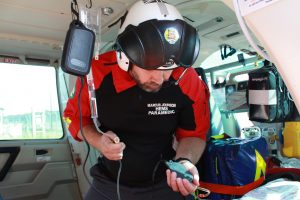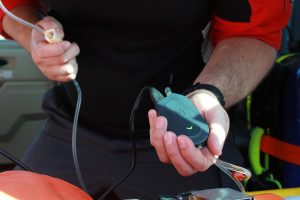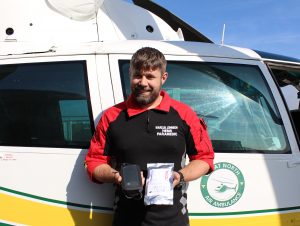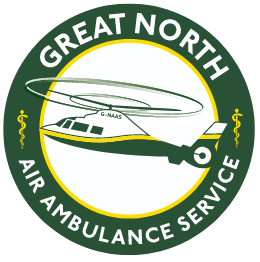When a patient is losing blood, seconds count. We invested in cutting-edge blood warmers to allow transfusions to be delivered faster. Paramedic Lee Salmon explains…
GNAAS started carrying blood on board all its flights in 2015. The innovation made an instant impact, saving lives across our region. But in the spirit of progress, we wanted to improve the way transfusions were delivered, and so in 2018, we introduced the MEQU blood warmer, which saves even more time, and thus even more lives.
GNAAS paramedic Lee Salmon filled us in on what impact this piece of technology has had since it was introduced:
Lee, what is this piece of equipment?
The MEQU warmers can warm up blood from cold to body temperature within seconds, making it safe to give to the patient and help prevent hypothermia and the complications from hypothermia.


What does it do?
The blood warmer essentially takes thawed plasma and red blood cells from very cold to body temperature or just over, so when we give blood it doesn’t cool the patient it warms them slightly.
Red blood cells carry oxygen round the body and plasma contains the clotting factors, which are proteins that make a blood clot and can stop bleeding. Together they equate more or less to whole blood.
Is it easy to use?
It’s simple to use! You just have to switch it on, attach the blue end to the blood product and the red end to the patient and hey presto.
We must act fast in the pre-hospital environment. Speed is vital so we have to be able to use products that are easy to implement so that the crucial treatment a patient needs can be started as soon as possible.
How does it work?
The blood product passes over a heating element to warm it to 37 degrees before it goes into the patient.
The small single use warmer is attached to the patient next to their intravenous (IV) entrance and the blood warming battery is attached to the stretcher they’re on so it means that there is reduced risk of pulling out the catheter.


Do you carry this on every flight?
Absolutely yes. The warming of blood is absolutely essential on each flight – it’s that that saves lives.
Because the warmer is lightweight and small it reduces the amount and size of the equipment we need to take with us in the air, yet still gives us the capacity to warm cold blood on a single charge of the power pack.
What injuries would you see on a patient to warrant using it?
A patient would have some form of a catastrophic bleed, whether that be from a cut to an artery or a rupture within one of the body’s cavities.


How much does it cost?
It’s quite expensive, every time we use it costs over £150 as well as the original set up costs. The blood warmers are single use per patient.
Can it mean the difference between life or death?
It can, we have used it on six occasions in the last six months where the patient would have died without the blood product it delivers.
When would a patient need it?
We use it when their blood pressure falls low enough not to have enough blood or pressure to carry oxygen to the brain or vital organs.
Has this changed the way you work?
Yes, it’s a much simpler process now, it’s also much quicker and more effective at heating the blood products. It means we have time to do other life-saving interventions!



